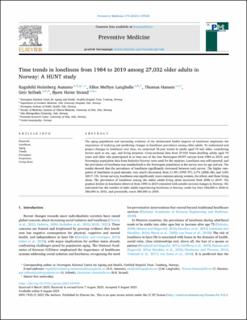Time trends in loneliness from 1984 ti 2019 among 27 032 older adults in Norway: a HUNT study
Aunsmo, Ragnhild Holmberg; Langballe, Ellen Melbye; Hansen, Thomas; Selbæk, Geir; Strand, Bjørn Heine
Peer reviewed, Journal article
Published version
Permanent lenke
https://hdl.handle.net/11250/3085899Utgivelsesdato
2023Metadata
Vis full innførselSamlinger
- NOVA rapport [424]
- Publikasjoner fra Cristin [3269]
Originalversjon
10.1016/j.ypmed.2023.107659Sammendrag
The aging population and increasing evidence of the detrimental health impacts of loneliness emphasize the importance of studying and predicting changes in loneliness prevalence among older adults. To understand and project changes in loneliness over time, we examined 35-year trends in adults aged 70 and older, considering factors such as sex, age, and living situation. Cross-sectional data from 27,032 home-dwelling adults aged 70 years and older who participated in at least one of the four Norwegian HUNT surveys from 1984 to 2019, and Norwegian population data from Statistics Norway were used for the analyses. Loneliness was self-reported, and the prevalence of loneliness was standardized to the Norwegian population at the survey year by age and sex. The results showed that the prevalence of loneliness significantly decreased between each survey. The higher categories of loneliness (a good amount, very much) decreased, from 11.4% (1995–97), 6.7% (2006–08), and 5.8% (2017–19). Across surveys, loneliness was significantly more common among women, the oldest, and those living alone. The prevalence of loneliness among the oldest adults living alone increased from 2006 to 2019. The gradual decline in loneliness observed from 1995 to 2019 coincided with notable societal changes in Norway. We estimated that the number of older adults experiencing loneliness in Norway could rise from 184,000 in 2020 to 286,000 in 2035, and potentially reach 380,000 in 2050. Time trends in loneliness from 1984 ti 2019 among 27 032 older adults in Norway: a HUNT study

